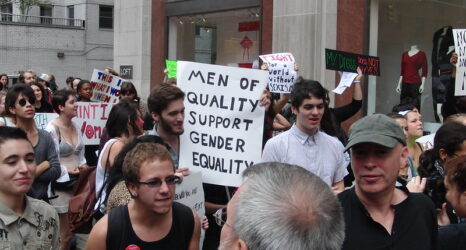When Marie Laguerre walked to her home in Paris last week, a man made obscene and degrading comments and “noises with sexual connotations” at her. Fed up with the accumulation of street harassment she had recently endured, she quietly told him to shut up. Angry that she had challenged him, the man threw an ashtray at her—then strode back to where she stood and forcefully slapped her.
The reason why I know about this incident in such specific detail is that it was recorded by a security camera. Laguerre chose to share the footage, leading to widespread media coverage. It wasn’t the only recent instance of a harasser caught on tape: a male patron in a Georgia restaurant grabbing waitress Emelia Holden from behind was also recorded by a security camera. (Like Laguerre, Holden fought back, grabbing him by the collar, slamming him onto a nearby counter—and yelling, “you don’t touch me, motherf—!”)
These incidents are unique for being recorded, but they are not unique in and of themselves. Street harassment, ranging from verbal comments to physical assaults, is a common experience for women.
In the U.S, around 65 percent of women have faced it, while 81 percent have faced some form of sexual harassment ever in their life, and more than half of women have experienced a physical form of sexual harassment. Street harassment is also a problem that extends globally: studies typically showing anywhere from 60 to 100 percent of women experiencing it worldwide.
Street harassment is also an old problem. The book Beware the Masher: Sexual Harassment in American Public Places highlights how the problem in the U.S. escalated between 1880 and 1930 as more women of all backgrounds began attending school, university, working outside the home and doing activities like shopping. Because women in those settings were usually unaccompanied by men, some passerby felt they were fair game for abuse. If you add racial discrimination into the mix, it gets worse: During segregation, there were white men who openly harassed, assaulted and raped Black women in public spaces.
New York City is historically a hotbed for street harassment. In 1970, newspapers routinely printed the commuting schedules and physical measurements of pretty women who worked on Wall Street, and some men lined up outside their workplaces to harass them. In a story she told for The Moth, Phyllis Bowdwin described how in 1979, a male mime near her downtown office made sport out of assaulting women walking by—and men ranging from executives to the food stand staff stood around egging him on, cheering at his exploits and booing anyone who tried to stop him.
But women like Laguerre and Holden have also been around for a long time; many women throughout history stood up to their harassers. Beware the Masher cites numerous newspaper articles about women who reported their harassers to the police, hit them with parasols and poked them with hat pins. In fact, the Montgomery Bus Boycott was largely led by and participated in by Black women who were fed up with not only racial discrimination, but also sexual harassment, by white, male bus drivers.
In response to the men who harassed women commuting to Wall Street, Karla Jay and Alix Kates Shulman organized an ‘ogle-in’ during which they yelled sexualized “compliments” at men on the street to “point out what it feels like to be whistled at, pointed at constantly every time we walk down the street.” (After the mime assaulted Bowdin and she observed him assaulting other women, she used the mace from the bottom of her purse and “sprayed him like a roach.”)
While street harassment still happens today, what is encouraging is that there is more widespread outrage than there was before. People do not typically stand around and egg on street harassers anymore. Newspapers do not facilitate harassment. Instead, videos showing street harassment spark public outrage—and new laws codify shifts away from a culture of abuse.
Last week, France passed a national law on street harassment. In the U.S., the Council of the District of Columbia recently passed the Street Harassment Prevention Act of 2018 (SHPA), the first legislation of its kind in the country—solely focusing on education and awareness-raising as a form of prevention. Since 2012, more than 20 laws against street harassment have also passed globally, with Romania and Manila in the Philippines as the two latest examples.
Of course, laws against street harassment can be flawed for many reasons. They may be too focused on criminalization instead of education as a form of prevention. They may inadvertently harm some populations, like populations of color. They may not be enforced properly or at all. They may not be well-publicized. There may not be funds allocated to train police and inform the public.
However, what is useful about laws is that they can signal what is okay—and what is not okay in a society.
In this sense, a law against street harassment is a big cultural step forward. Because of laws, and especially thanks to individuals who speak out against street harassment, men’s abuse of women in public spaces will hopefully soon be socially unacceptable—and come to an end.





